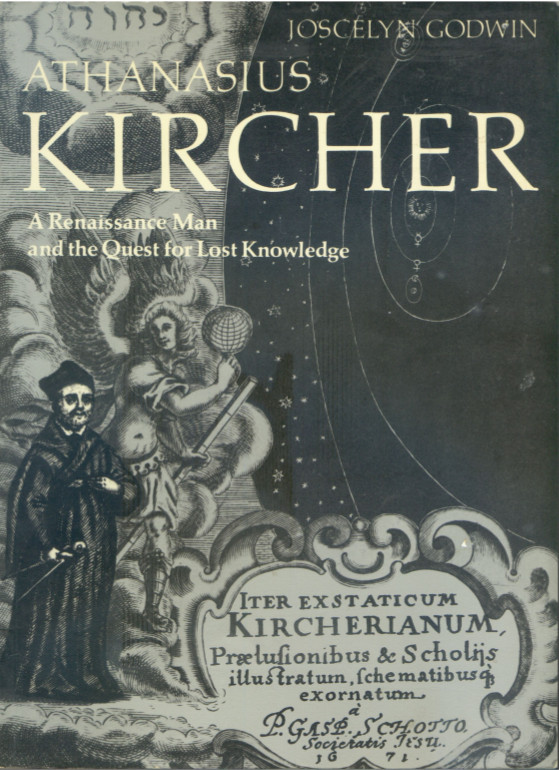Joscelyn Godwin: Athanasius Kircher: A Renaissance Man and the Quest for Lost Knowledge (1979)
Filed under book | Tags: · 1600s, archaeology, history of science, history of technology, kabbalah, linguistics, magnetism, music, mysticism, optics, religion, science, technology

Athanasius Kircher (1602-80) stands out as one of the last all-encompassing minds, living in the age of Descartes and Newton, but expounding his knowledge in the light of a unified, spiritual world-view. For this true Renaissance man, the whole cosmos was a glorious theophany waiting to be explored.
Kircher was a Jesuit and an archeologist, a phenomenal linguist and an avid collector of scientific instruments and geographical exploration. He probed the secrets of the subterranean world, deciphered archaic languages, experimented with alchemy and music-therapy, optics and magnetism.
Egyptian mystery wisdom, Greek, Cabbalistic and Christian philosophy met on common ground in Kircher’s work; his sumptuous, encyclopaedic volumes were revered throughout Europe. His gigantic oeuvre is approached here through striking engravings – most of them reprinted for the first time – together with annotations and an introduction to Kircher’s life and work.
Publisher Thames & Hudson, 1979
Art and Imagination series
ISBN 0500810222, 9780500810224
96 pages
PDF (121 MB, no OCR)
Comment (0)Michel Foucault: The Archaeology of Knowledge (1969-) [FR, ES, IT, EN, BR-PT, AR, SR, TR, CZ, RU]
Filed under book | Tags: · archaeology, discourse, epistemology, knowledge, knowledge production, language, method, philosophy, philosophy of history, theory

“The Archaeology of Knowledge (L’archéologie du savoir) is a methodological treatise promoting what the French philosopher Michel Foucault calls “archaeology” or the “archaeological method”, an analytical method he implicitly used in his previous works Madness and Civilization, The Birth of the Clinic, and The Order of Things. It is Foucault’s only explicitly methodological work.
The premise of the book is that systems of thought and knowledge (“epistemes” or “discursive formations”) are governed by rules (beyond those of grammar and logic) which operate in the consciousness of individual subjects and define a system of conceptual possibilities that determines the boundaries of thought in a given domain and period.” (from Wikipedia)
French edition
Publisher Editions Gallimard, 1969
275 pages
English edition: The Archaeology of Knowledge and the Discourse on Language
Translated by A. M. Sheridan Smith
Discourse on Language was originally published in French as L’ordre du discours, Editions Gallimard, 1971. English translation by Rupert Swyer
Publisher Pantheon Books, New York, 1972
ISBN 0394711068
246 pages
via esco_bar
L’archéologie du savoir (French, 1969, no OCR)
La arqueología del saber (Spanish, trans. Aurelio Garzón del Camino, 1970/2002, no OCR)
L’archeologia del sapere: Una metodologia per la storia della cultura (Italian, trans. Giovanni Bogliolo, 4th edition, 1971/2009, via oize, EPUB)
The Archaeology of Knowledge and the Discourse on Language (English, trans. A. M. Sheridan Smith and Rupert Swyer, 1972). Routledge Classics edition (2002, added on 2013-6-28)
A Arqueologia do Saber (BR-Portuguese, trans. Luiz Felipe Baeta Neves, 7th edition, 1972/2008, no OCR, no OCR)
حفريات-المعرفة-فوكو (Arabic, 1987, no OCR)
Arheologija znanja (Serbian, trans. Mladen Kozomara, 1998, no OCR)
Bilginin arkeolojisi (Turkish, trans. Veli Urhan, 1999, no OCR)
Archeologie vědění (Czech, trans. Čestmír Pelikán, 2002, no OCR)
Археология знания (Russian, trans. М. Б. Ракова and А. Ю. Серебрянникова, 2004, PDF, added on 2013-9-26), DJVU
Meta F. Janowitz, Diane Dallal (eds.): Tales of Gotham, Historical Archaeology, Ethnohistory and Microhistory of New York City (2013)
Filed under book | Tags: · 1600s, 1700s, 1800s, anthropology, archaeology, city, ethnoarchaeology, ethnography, history, new york

“Historical Archaeology and Ethnohistory of New York City: Tales and Microhistory of Gotham is a collection of narratives about people who lived in New York City during the seventeenth, eighteenth, and nineteenth centuries, people whose lives archaeologists have encountered during excavations at sites where these people lived or worked. The stories are ethnohistorical or microhistorical studies created using archaeological and documentary data. As microhistories, they are concerned with particular people living at particular times in the past within the framework of world events.
The world events framework will be provided in short introductions to chapters grouped by time periods and themes. The foreword by Mary Beaudry and the afterword by LuAnne DeCunzo bookend the individual case studies and add theoretical weight to the volume. Topics in the book include:
– Native Americans and Europeans in New Amsterdam
– Stories of Dutch women in the colonial period
– African history in New York City, including the African Burial Ground
– Craftsmen and Churchmen of New York City
– A portrait of Stephen Allen, a New York City Mayor
Historical Archaeology and Ethnohistory of New York City: Tales and Microhistory of Gotham focuses on specific individual life stories, or stories of groups of people, as a way to present archaeological theory and research. Archaeologists work with material culture—artifacts—to recreate daily lives and study how culture works; this book is an example of how to do this in a way that can attract people interested in history as well as in anthropological theory. As such, this volume is an invaluable resource for archaeologists, historians, ethnographers, anthropologists, and anybody interested in the rich history of one of the world’s most influential cities, New York City.”
With a Foreword by Mary Beaudry
With an Afterword by LuAnne DeCunzo
Publisher Springer, London, 2013
ISBN 1461452716, 9781461452713
369 pages

